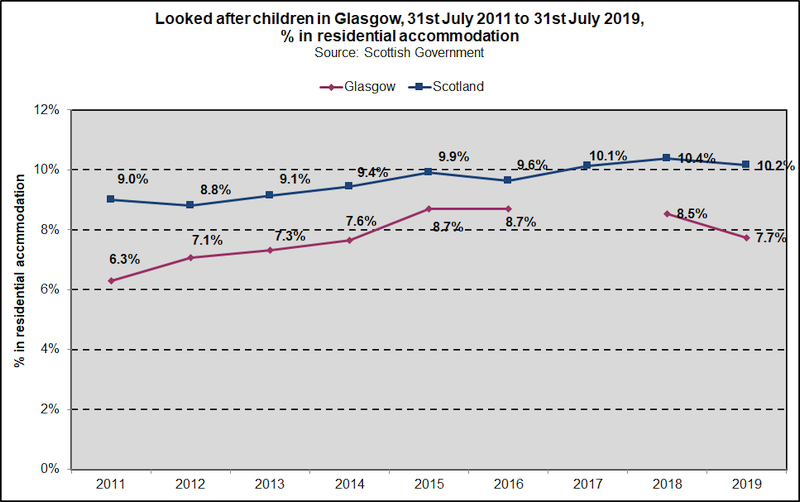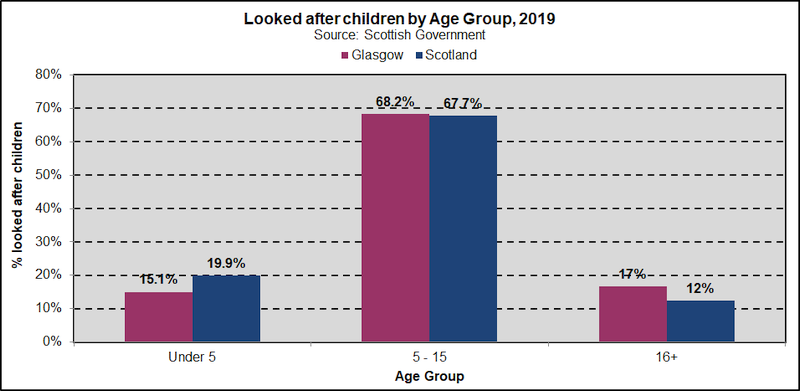Glasgow
Glasgow had more than 3,500 looked-after children as at 31st July 2010 – a number far higher than any other local authority in the country. This equates to 3% of the child population, the highest rate of any authority within Scotland, and more than double the Scottish average of 1.4%.
Looked-after children and young people are those under the supervision of Social Work Services, who are living at home with their parent(s) or living away from home in various settings. The Scottish Children's Reporters Administration (SCRA) is also involved in the supervision of many of these children and young people.
Placements of children and young people away from home may be within a community setting – with friends and relatives, foster carers, prospective adopters or other community placements, or they may be residential – in residential care, residential schools or secure care. Where children and young people are looked after away from home, they are said to be looked after and accommodated.
Looked-after children in Glasgow and Scotland by accommodation typeThe accommodation profiles of looked-after children in Glasgow and Scotland in 2019 were broadly similar. The majority of looked-after children either live at home with their parents or with relatives/friends, although the percentage of looked-after children living at home with their parents is much lower in Glasgow than in Scotland as a whole.
Only about 7% of looked-after children live in residential accommodation in Glasgow, compared to 10% overall in Scotland.
Looked-after children in Glasgow and Scotland by age group
The vast majority of looked-after children in Glasgow and Scotland are between the ages of five and 15. There are slightly greater proportion of children aged 16 and over who are looked after in Glasgow compared to Scotland but a slightly lower proportion of looked-after children under five.
Looked-after children in residential accommodation, Glasgow and Scotland

The numbers of children in Glasgow who were looked after has declined in recent years. Looked-after children living at home with their parents has seen the largest decrease since 2011.
There is a lower percentage of looked-after children living in residential accommodation in Glasgow than in Scotland as a whole. In recent years, the rate has declined slightly to 7.7% in Glasgow. There are fewer looked-after children in residential accommodation than being looked after in the community.
Notes
Looked-after children - This indicator reports information on numbers of 'looked after' children and care leavers, aged 0 to 21 years. Estimates of the 0-18 years population are applied to calculate relative measures of percentage of the child population. (Few children aged 18+ are 'looked after' which explains why the population base used is 0-18 years rather than 0-21 years).
Data for this indicator at Scotland and Scottish local authority level, including Glasgow City Council, was sourced from the Scottish Government annual report on Children Looked After Statistics. This report is compiled by the Scottish Government from annual data returns on 'looked after' children and care leavers, which are submitted by all 32 local authorities in Scotland. Some information at Glasgow and sub Glasgow level was extracted from Social Work Services monthly performance reports.
Children most commonly become 'looked after' following a referral to the Children's Reporter.
In the chart showing the percentage of looked-after children in residential accomodation, the 2017 figure for Glasgow is unavailable due to the data being suppressed at source.
The number of children who are social work service users (including those 'looked after' and accommodated or on the Child Protection Register) is derived from careFirst (the client information system used by Glasgow City Council Social Work Services); population estimates for areas within Scotland are obtained from the National Records of Scotland (NRS) (formerly GROS) or from the Office for National Statistics (ONS) for English local authorities and numbers/rates of children referred to the Children’s Reporter are drawn from the SCRA website.

